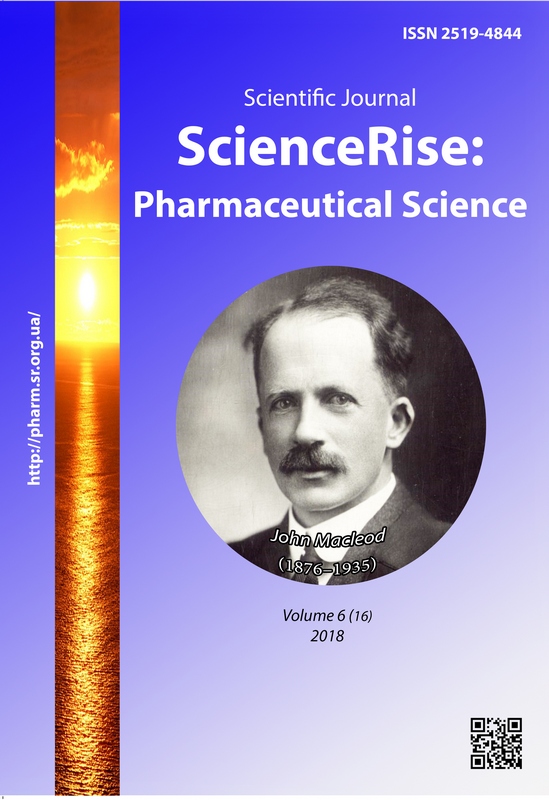Розробка ВЕРХ-методу для кількісного визначення нового перспективного апи з анти-вузлів активністю тріазопразола
DOI:
https://doi.org/10.15587/2519-4852.2018.153387Ключові слова:
1, 2, 4-триазолу, триазопразол, противиразкова активність, аналіз, кількісне визначення, метод ВЕРХ, діодно-матричний детекторАнотація
Мета. Розробка оптимальної, високоточної, відтворюваної методики кількісного визначення основної речовини у субстанції триазопразолу методом високоефективної рідинної хроматографії.
Матеріали та методи. Для досягнення поставленої мети використовували фізико-хімічний (високоефективна рідинна хроматографія) та математичний (статистична обробка результатів) методи дослідження. Хроматографування проводили на рідинному хроматографі Agilent 1290 Infinity II з діодно-матричним (LC 1290) детектором та квадрупольно-часпролітним (QTOF 6530) мас-детектором. Нерухома фаза: колонка хроматографічна 100×2,1 мм, заповнена силікагелем октадецилсилільним для хроматографії РZorbax Eclipse Plus C18, із розміром часток 3,5 мкм. Рухома фаза А: 0,1 % розчин мурашиної кислоти Р у воді Р. Рухома фаза В: 0,1 % розчин мурашиної кислоти Р у ацетонітрилі Р. Швидкість потоку рухомої фази 0,6 мл/хв. Температура колонки 30 ºС. Об’єм інжекції 5 мкл. Детектор – діодно-матричний (DAD). Детектування за довжини хвилі 248 нм. Налаштування детектора (Q-TOF): тип іонізації: позитивний, електроспрей (+ESI); режим вимірювання: сканування іонів з масою від 100 до 1000 а.о.; напруга на фрагментаторі: 100 В; температура азоту: 350 ºС; витрата азоту: 10 мл/хв; тиск небулайзера: 35 PSI; напруга на капілярі: 4 Кв. Хроматографічне розділення проводили при градієнтному елююванні на колонці, заповненій силікагелем октадецилсилільним.
Результати. Вміст діючої речовини у субстанції триазопразолу відповідав вимогам щодо регламентованих меж кількісного вмісту. Тому запропонована методика може бути використана в процесі фармацевтичної розробки та стандартизації лікарської форми. Крім того в умовах запропонованої методики визначенню діючої речовини не заважають ні розчинник, ні рухома фаза, що свідчить про специфічність методики.
Висновки. Вперше розроблена високоточна та відтворювана методика кількісного визначення основної речовини у субстанції триазопразолу методом високоефективної рідинної хроматографії
Посилання
- Kaur, P., Chawla, A. (2017). 1,2,4-Triazole: a review of pharmacological activities. International Research Journal of Pharmacy, 8 (7), 10–29. doi: http://doi.org/10.7897/2230-8407.087112
- Namratha, B., Gaonkar, S. (2014). 1,2,4-triazoles: Synthetic strategies and pharmacological. International Journal of Pharmacy and Pharmaceutical Sciences, 6 (8), 73–80.
- Felton, L. A. (Ed.) (2013). Remington – Essentials of Pharmaceutics. Pharmaceutical Press, 772.
- Georgiyants, V., Perekhoda, L., Saidov, N., Kadamov, I. (2014). Synthesis, docking studies, and biological evaluation of anti-ulcer activity of 4-allyl-5-(4-R1)-phеnylthiomethyl-1,2,4-trіаzоle-3-ylmercaptoаcetic acid derivatives. European Chemical Bulletin, 3 (5), 466–471.
- Georgiyants, V., Severina, G., Drogovoz, S., Timofeev, М., Saidov, N., Kadamov, І., Saaod, Khaidar (2016). Pat. No. 112867 UA. Zastosuvannia alkilovanykh pokhidnykh 1,2,4-tryazol-3-tiolu ta 1-fenil-1n-tetrazol-5-tiolu yak zasobu protyvyrazkovoi dii. MPK: С07D 249/08 (2006.01), С07D 257/04, A61K 31/41, A61K 31/4196. No. u 2013 13290; declareted: 15.11.2013; published: 10.11.2016, Bul. No. 10.
- Kenesov, B., Saylauhanulyi, E., Musrepov, B., Kaldarov, A. (2008). Opredelenie 1-methyl-1H-1,2,4-triazole v vodnyih obraztsah metodom vyisokoeffektivnoy zhidkostnoy hromatografii s diodno-matrichnyim detektirovaniem. Habarshyi vestnik. Seriya himicheskaya, 1 (49), 184–189.
- Yegemova, S., Bakaikina, N. V., Kenessov, B., Koziel, J. A., Nauryzbayev, M. (2015). Determination of 1-methyl- 1H -1,2,4-triazole in soils contaminated by rocket fuel using solid-phase microextraction, isotope dilution and gas chromatography–mass spectrometry. Talanta, 143, 226–233. doi: http://doi.org/10.1016/j.talanta.2015.05.045
- Tatarczak-Michalewska, M., Flieger, J., Wujec, M., Swatko-Ossor, M. (2014). Isolation and Quantitative Determination of New Tuberculostatic 1,2,4-Triazole Derivative in Urine and Plasma Samples. Journal of Analytical & Bioanalytical Techniques, 5 (4). doi: http://doi.org/10.4172/2155-9872.1000206
- Acanski, M., Perisic-Janjic, N., Dimova, V. (2003). Normal and reversed phase high performance liquid chromatography of some new 1, 2, 4-triazole derivatives. Acta Periodica Technologica, 34, 83–92. doi: http://doi.org/10.2298/apt0334083a
- Hawryl, A., Kusmierz, E., Hawryl, M., Swieboda, R., Wujec, M. (2014). Determination of Lipophilicity of New Thiosemicarbazide and 1,2,4-triazole-3-thione Derivatives Using Reversed-Phase HPLC Method and Theoretical Calculations. Journal of Liquid Chromatography & Related Technologies, 38 (4), 430–437. doi: http://doi.org/10.1080/10826076.2014.913519
- Varynskyi, B., Kaplaushenko, A. (2017). The development and validation of HPLC-DMD method for intermediate products impurities determination of morpholinium2-((4-(2-methoxyphenyl)-5-(pyridine-4-yl)-4H-1,2,4-triazole-3-yl)thio)acetate in bulk drug. Zaporozhye Medical Journal, 9 (3), 373–380. doi: http://doi.org/10.14739/2310-1210.2017.3.100947
- Blondel, A., Krings, B., Ducat, N., Pigeon, O. (2018). Validation of an analytical method for 1,2,4-triazole in soil using liquid chromatography coupled to electrospray tandem mass spectrometry and monitoring of propiconazole degradation in a batch study. Journal of Chromatography A, 1562, 123–127. doi: http://doi.org/10.1016/j.chroma.2018.05.056
- Sanagi, M., Heng, S., Ibrahim, W., Naim, A. (2004). High temperature high performance liquid chromatography of triazole fungicides on carbon-clad zirconia stationary phase. Malaysian Journal of Chemistry, 6 (1), 55–66.
- Derzhavna Pharmakopeya Ukrayini. Vol. 1 (2015). DP «Naukovo-ekspertniy farmakopeyniy tsentr». Kharkiv: DP «Ukrayinskiy naukoviy farmakopeyniy tsentr yakosti likarskih zasobiv», 1128.
- Saidov, N., Kadamov, I., Perehoda, L., Georgiyants, V. (2017). Razrabotka metodiki kolichestvennogo opredeleniya potentsialnogo AFI s protivoyazvennyim deystviem. Nauka i innovatsii, 4, 35–41.
##submission.downloads##
Опубліковано
Як цитувати
Номер
Розділ
Ліцензія
Авторське право (c) 2018 Narzullo Saidov

Ця робота ліцензується відповідно до Creative Commons Attribution 4.0 International License.
Наше видання використовує положення про авторські права Creative Commons CC BY для журналів відкритого доступу.









